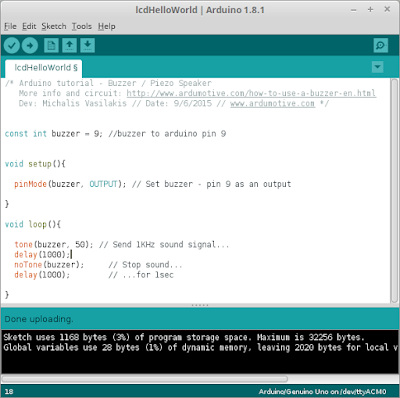

Steps to use Buzzer with Arduino Step 1: First, grab all the components listed above.I did the Star Spangled Banner! SparkFun provided the base. Component required to interface buzzer with Arduino:
#ARDUINO PIEZO CODE CODE#
So let’s see the complete code and the connection for playing music on the Arduino buzzer. (Note: The same pin has to be used, which was used for the tone generation). In the noTone() an argument with the pin number has to passed, which says the Arduino that to stop the frequency generation on a particular pin. įor stopping the frequency generation, generated by the tone() function, the above function has to be called. NoTone(9) // Stops the generation of a square wave triggered by tone(). If you do not call the noTone() function, it will keep making a tone until you tell it to stop by calling noTone(pin) or by calling tone() with a different frequency. The syntax for the noTone() function is mentioned below. Once, the square wave is generated as per what we declared in the tone() function, to stop the frequency generation noTone() function has to be used. The 1200 stands for the frequency you want to generate, and the 500 stands for time in milliseconds, this is the time period that the Arduino generates the frequency for the buzzer.Īlso Read - IR Sensor Interfacing with Arduino As per the above-mentioned command, 9 stands for the pin number of the pin you want to use, (Note that the pin you use for this operation should be a PWM pin). I.e, Pin number, frequency of the signal you want to generate, and the time in milliseconds.

When you call the tone() function, you have to pass this function with 3 arguments. So we are using pin number 9 of Arduino to perform such an operation here. The above-mentioned command is the function used to generate an electric signal of a particular frequency and for a particular period of time on a particular pin. So for doing this, we will use the Arduino buzzer tone generation command : You have to tell the Arduino on which pin the buzzer is connected, what should be the frequency (in Hertz, Hz) of the electric pulse has to be applied to the buzzer, and for how much time you want it to keep making the tone. Using the Arduino, you can make sounds with a buzzer by using different frequency electrical pulses. Connect the short pin of the buzzer to the Arduino's ground pin (GND) and the other end to digital pin 9. If your buzzer has a sticker on top of it, pull the sticker off. By changing the frequency on the positive pins of the Arduino buzzer, we can create a melody of the song. The different frequencies generate different tones. When a square wave of a certain frequency (and 50% duty cycle) is applied on the Positive (+ve) pin of the Arduino buzzer generates tones. When the Positive pin is connected to the 5 Volts pin of the Arduino directly, the buzzer produces a sound of constant frequency.

The Positive pin (+ve) of the Arduino buzzer has to be connected to the VCC of Arduino and the Negative pin (-ve) has to be connected to the GND pin of the Arduino. In this blog, we will produce different sound tones using a buzzer by applying different frequency electric pulses. As it is lightweight, simple in construction, typically a low-cost product that can generate different sound tones of different frequencies and does not require a separate oscillating circuit. The piezoelectric buzzer is most commonly used with the Arduino. The buzzers are of different types such as Mechanical buzzers, Electromechanical buzzers and Piezoelectric buzzers. The Arduino buzzers are most commonly used as beepers in any system, Alarm devices, timers, security systems and to produce sound on confirmation of user input in many systems. The Arduino buzzer can be directly connected to the Arduino and produce different tones by giving different frequency electric pulses to the buzzer. The Arduino buzzer is a device that produces sound when an electric current is passed through it.


 0 kommentar(er)
0 kommentar(er)
